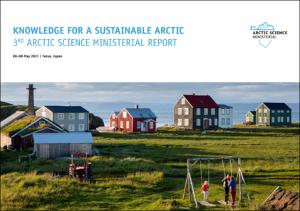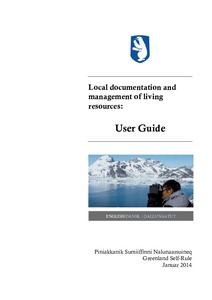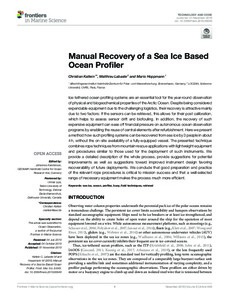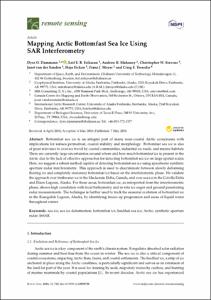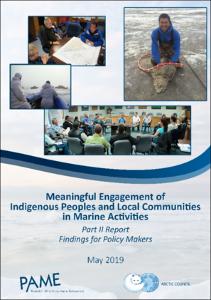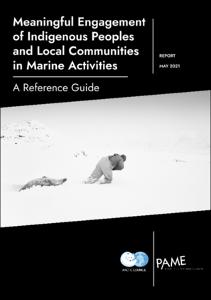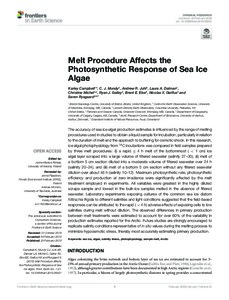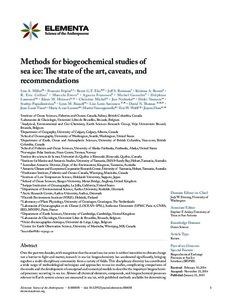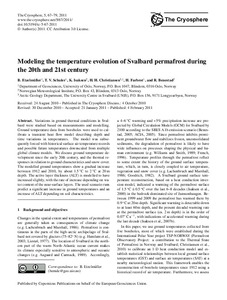Browsing CAPARDUS Practices by Title
Now showing items 143-162 of 244
-
Knowledge for a sustainable Arctic, 3rd Arctic Science Ministerial Report, 08–09 May 2021 | Tokyo, Japan.
(Ministry of Education, Science and Culture, Reykjavík, Iceland, 2021)To strengthen international cooperation and respond to the severe threat of climate change and biodiversity loss in the Arctic, the Icelandic Ministry of Education, Science and Culture and the Japanese Ministry of ... -
Lead Detection in Polar Oceans: A Comparison of Different Classification Methods for Cryosat-2 SAR Data.
(2018)In polar regions, sea-ice hinders the precise observation of Sea Surface Heights (SSH) by satellite altimetry. In order to derive reliable heights for the openings within the ice, two steps have to be fulfilled: (1) the ... -
Learning Polar Encodings for Arbitrary-Oriented Ship Detection in SAR Images.
(2021)Common horizontal bounding box-based methods are not capable of accurately locating slender ship targets with arbitrary orientations in synthetic aperture radar (SAR) images. Therefore, in recent years, methods based on ... -
Less Surface Sea Ice Melt in the CESM2 Improves Arctic Sea Ice Simulation With Minimal Non-Polar Climate Impacts.
(2022)This study isolates the influence of sea ice mean state on pre-industrial climate and transient 1850-2100 climate change within a fully coupled global model: The Community Earth System Model version 2 (CESM2). The CESM2 ... -
Local documentation and management of living resources: User Guide. [PISUNA Manual]
(Piniakkanik sumiiffinni nalunaarsuineq (PISUNA), Nuuk, Greenland, 2014)Welcome to Greenland Self-Government’s Guide to Local Documentation and Management of Living Resources! This guide is intended to help citizens document and interpret changes in living resources. The guide has been written ... -
Management and utilization of seals in Greenland, February 2015. Addendum to: White Paper on Management and Utilization of Seals in Greenland (April 2012).
(Government of Greenland, Department of Fisheries, Hunting & Agriculture, Greenland, 2015)This document is an addendum to the White Paper on Management and Utilization of Seals in Greenland from April 2012 and the two documents should be read together. Box 1: Abundant seal populations Harp seal: Advice on ... -
Management and utilization of seals in Greenland. Revised April 2012.
(Government of Greenland, Department of Fisheries, Hunting & Agriculture, Greenland, 2012)1. Species: There are six different species of seals in the Greenlandic waters. Five of the species have been hunted for centuries, but today the catch is focused on the harp seal, ringed seal and hooded seal with great ... -
Manaus Letter: Recommendations for the Participatory Monitoring of Biodiversity.
(Participatory Monitoring and Management Partnership (PMMP), Manaus, Brasil, 2015)Recommendations regarding best practices for participatory, community-based monitoring of biodiversity and natural resource use developed by the participants of the large International Seminar on Participatory Monitoring ... -
Manual Recovery of a Sea Ice Based Ocean Profiler.
(2019)Ice-tethered ocean profiling systems are an essential tool for the year-round observation of physical and biogeochemical properties of the Arctic Ocean. Despite being considered expendable equipment due to the challenging ... -
Mapping Arctic Bottomfast Sea Ice Using SAR Interferometry.
(2018)Bottomfast sea ice is an integral part of many near-coastal Arctic ecosystems with implications for subsea permafrost, coastal stability and morphology. Bottomfast sea ice is also of great relevance to over-ice travel by ... -
Marine mammal ecology and health: finding common ground between conventional science and indigenous knowledge to track arctic ecosystem variability.
(2019)Marine mammals respond to, and thereby reflect, changes in Arctic ecosystems that are important both to practitioners of conventional science (CS) and to holders of indigenous knowledge (IK). Although often seen as contrasting ... -
Marine snow morphology illuminates the evolution of phytoplankton blooms and determines their subsequent vertical export.
(2021)The organic carbon produced in the ocean’s surface by phytoplankton is either passed through the food web or exported to the ocean interior as marine snow. The rate and efficiency of such vertical export strongly depend ... -
Meaningful engagement of Indigenous Peoples and Local Communities in marine activities. Part II Report: Findings for Policy Makers.
(Protection of the Arctic Marine Environment (PAME), Akureyri, Norway, 2019)Indigenous peoples and local communities living in coastal communities in the Arctic have always depended on the sea for food, transportation, cultural and spiritual identity and social well-being. Increasingly, the sea ... -
Meaningful Engagement of Indigenous Peoples and Local Communities in Marine Activities: A Reference Guide.
(Protection of the Arctic Marine Environment (PAME), Akureyri, Iceland, 2021)This Reference Guide is meant to familiarize proponents of actions or activities in the Arctic and Indigenous Peoples and local communities with good practices for meaningful engagement. It is based on the Meaningful ... -
Melt Procedure Affects the Photosynthetic Response of Sea Ice Algae.
(2019)The accuracy of sea ice algal production estimates is influenced by the range of melting procedures used in studies to obtain a liquid sample for incubation, particularly in relation to the duration of melt and the ... -
A method for evaluating operational implications of regulatory constraints on Arctic shipping.
(2022)Development of effective marine policy necessitates evidence-based, data-driven evaluations of the effects of regulatory constraints on operations. This is essential to better understand implications of policy decisions ... -
A method to extract fishers’ knowledge (FK) to generate evidence for sustainable management of fishing gears.
(2019)The dangerous effects of Abandoned, Lost or Discarded Fishing Gears (ALDFG) is documented in the literature. However, there exists an overall lack of understanding in quantifying the pollution loads of fishing gears (FG) ... -
Methods for biogeochemical studies of sea ice: the state of the art, caveats, and recommendations.
(2015)Over the past two decades, with recognition that the ocean’s sea-ice cover is neither insensitive to climate change nor a barrier to light and matter, research in sea-ice biogeochemistry has accelerated significantly, ... -
Modeling Functional Organic Chemistry in Arctic Rivers: An Idealized Siberian System.
(2020)Rivers of the Arctic will become ever more important for the global climate, since they carry a majority of continental dissolved organic carbon flux into the rapidly changing polar ocean. Aqueous organics comprise a wide ... -
Modeling the temperature evolution of Svalbard permafrost during the 20th and 21st century.
(2011)Variations in ground thermal conditions in Svalbard were studied based on measurements and modelling. Ground temperature data from boreholes were used to calibrate a transient heat flow model describing depth and time ...
 Repository of community practices in Ocean Research, Applications and Data/Information Management
Repository of community practices in Ocean Research, Applications and Data/Information Management
